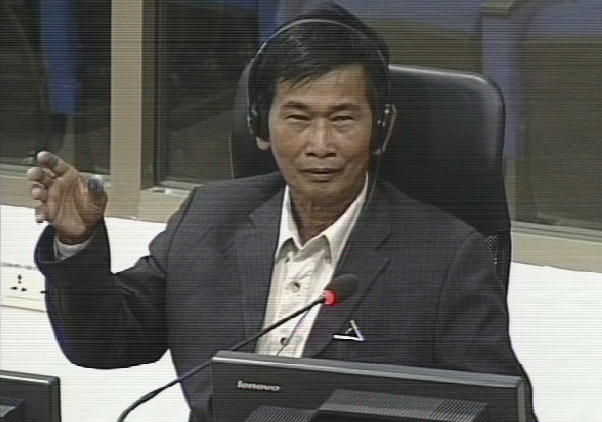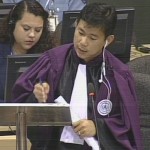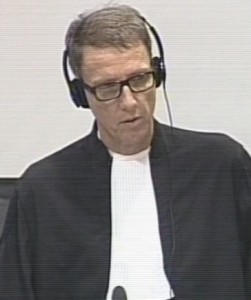“If We Joked About It, The Fear Would Remain With Us”
In testimony begun the day before, the Trial chamber continue to hear Witness Mr. Uth Seng, 59.
Mr. Uth was born on the 7th of January of 1956. Since 1980 he has worked as an official at the Kampong Thom Water Resources and Meteorological Division. He has three children: two sons and one daughter.
He has been interviewed once by the OCIJ in 2005 or 2006 near the Stung Chinit Dam.
Mr. Srea Rattanak, Deputy Co–Prosecutor, started the questioning.
Mr. Uth was in Phnom Penh in April 17, 1975. He lived there with his elder sister. He was studying at the Tuol Tompong High School. When he was evacuated by the Khmer Rouge he went to the village where he was born in Kampong Thmor Commune. It took him one-month to reach his destination. Mr. Uth said that his village is located near the 1st of January Dam Site.
His father and him were considered “April 17 People” (since they had come back to their home town) while his mother and sister were considered “Base People.”
In 1976 Mr. Uth was in the commune of Kampong Thmor district, Kampong Thom Province. He was assigned to dig canals and build the 1st of January Dam. Mr. Uth was part of a youth group that consisted of 33 members who were divided into groups of ten or twelve.
Mr. Uth said that at the worksite: “If one did not try to work hard he or she would be killed.”
Lazy-people group
Mr. Uth explained that there was a special group called the “lazy-people” group. It consisted of about twenty members he said. This special unit had to work harder and received less food rations. He said he knew about this because he was told about it in the meetings. He said there were special groups like this one to deter people.
With the questions of Mr. Travis Farr, Senior Assistant Prosecutor, Mr. Uth was able to further explain who the special group of “lazy-people” consisted off.
Mr. Uth said that the “lazy-people” unit was for people who had violated work related “disciplines” [sic] or rules, or for people who had attempted to run away to their villages.
Mr. Uth explained that some mornings, either of the two unit chiefs of this unit (one male or one female) would line the unit members up and whip them at the shins. They did this “so the rest of the workers could see and not follow their example,” Mr. Uth added.
These whippings did not happen often but the Mr. Uth clarified that sometimes he did not work close to that unit, so maybe for that reason he didn’t see them that often.
Mr. Farr asked them how the “lazy-people” reacted to the whippings as they were being whipped:
“They remained still and quiet,” Mr. Uth replied.
There were no major injuries, although there would be whipping marks on the lower part of their legs, but “we could not discuss [these whippings],” Mr. Uth clarified, “if others overheard us there would be trouble. If we joked about it, the fear would remain with us. So we usually resorted to that phrase we use in Khmer, Chop Niyeay Chreoun, we remained with our mouths shut.”
Night sessions
Mr. Uth confirmed that night shifts only happened on special occasions. He went on to say that the special occasions was that it was easier to arrest people at night. He said he knows this because once when he was working some people disappeared.
Mr. Uth said this night work only happened once.
That time, Mr. Uth said that the next day he had had overheard a militia man and the chief of the youth unit discussing how they had killed a few workers.
“I heard those workers were put in a well. . . 2 or 3 people but I’m not sure. I was very frightened. I did not know when my turn would come.”
Mr. Farr asked why he was afraid that his turn would come.
“At that time we survived day by day. When we woke up in the morning, we made sure we lived for that day. “
Chief-Executioner
Mr. Uth said that he had seen guards carrying knifes with dried blood on them. “On our own we became afraid of dying,” he added. When asked where he had seen the dried blood, Mr. Uth explained that it was one time he went to the village and “met with the executioner Lun. . . Lun was the chief of militia of Kampong Thom commune.”
Mr. Farr then read from Mr. Uth’s OCIJ interview:
““There was a chief executioner named Lun. He had a bicycle and had a sword on his bicycle.” Mr. Farr then added, “ and then you mention where he lives today.”
Mr. Uth explained: “After the Vietnamese liberation (January 7, 1979] he was imprisoned and that’s why he survived. Otherwise the people would have killed him without doubt. “
Mr. Uth explained that Lun rarely went to the 1st January Dam. Most of the time Lun stayed at the village were there were many “17 April people.”
Mr. Farr then asked the Chamber, with its leave to show a document to the witness to see if he could identify Lun therein without revealing his full name as Lun may be a potential witness.
At this point, Mr. Victor Koppe, Co-Lawyer for Nuon Chea, objected on the grounds that 1) Mr. Uth had no personal knowledge of whether Lun executed people and 2) that it was out of the scope of the trial as the witness had just established that Lun never went to the 1st January Dam.
Mr. Farr replied that in as much as the Wat Baray Choan Dek Pagoda was relevant, this information was relevant and furthermore this person he was seeking to identify was a person that was an upcoming witness in this case.
The bench overruled the objection and allowed Mr. Farr to show the document to Mr. Uth.
Mr. Uth confirmed that the witness Lun, 2TCW830, was the Lun he was speaking about.
Cham People
“The Cham people were also killed during that era,” Mr. Uth testified. “One day when I awoke, all the Cham people disappeared [from his village Kaung Sao].”
“There were 10 families in my village and only one person survived–she was far away at the time they were taken away. After 1979 I met only that individual who survived but then I never saw her again. . . I never met any of the other Cham families since that time.”
Pagoda
Mr. Uth explained that he did not know about the Wat Baray Choan Dek Pagoda at the time he was at the 1st January Dam worksite, but that he learned in 1979 that it was the place where they killed people.
“In 1979, I went to that pagoda and I saw large graves in that pagoda . . . people went there to dig the dead bodies to find gold. . .[and] valuable belongings. People were saying that there was gold.”
Mr. Farr tried to understand what Mr. Uth had meant when he said in his OCIJ interview that: “they brought the people in front of the pagoda and killed them right there.”
“When I tended the cows and cattle,” Mr. Uth answered, “I heard the music. It was so loud and I couldn’t hear anything. But people who went there [everyday] told me that when music was playing people were getting killed . . . they said that they could sometimes hear the screams.”
Cross-examination
Mr. Victor Koppe, Co-Lawyer for Nuon Chea, focused on the benefits the Dam may have brought to the people after 1979.
“Did rice production by the farmers in that area increase [after 1979]?” Koppe asked.
“The dam was very beneficial and the water could be irrigated to the fields. And harvests appeared to be good. The harvest was about three tons per year or a bit lower than that.”
“Is it fair to say then that the dam worked properly and that the farmers profited from it?”
“Yes that’s correct,” Mr. Uth answered.
Mr. Koppe then moved on to try to understand how the people at the kitchen knew whether people were “Base People” or “New People,” (also called “17 April People”). This was important because the witness had said that new people and base people received different food rations.
Mr. Uth explained that it was because of the clothes they were wearing. “If they had ragged clothes they were “17 April people”.
Mr Koppe then asked, “There were 500 or 600 people in your unit. How did they know?”
Mr. Uth repeated:
“It is my understanding that they recognized the difference by their clothing. If the clothes were torn, then they recognized they were “17 April People.” If the clothes were new, they were ‘Base People.’” Mr. Uth then added that the bowls they used might have also distinguished them.
Mr. Koppe then moved on to the “Lazy-People” unit. Mr. Uth explained that it indeed was smaller at the beginning and as people became more exhausted from overwork, new members were added. [The witness had said earlier that it consisted of 20 workers].
After the lunch break, Mr. Koppe told Mr. Uth that he heard the audio interview of his OCIJ interview.
Mr. Koppe stated that in that interview Mr. Uth said that he was “not forced to work, that you could finish the next day.” He asked Mr. Uth “Is that true?”
“It appears that I made such statement,” Mr. Uth answered.
“As long as the workers in the group were not lazy there wouldn’t be any problem.”
“Yes that is correct. Nothing happened to us.”
“Is it fair to say that 97% of your workers had no problem?” Mr. Koppe asked.
“That is true.”





[…] Ms. Sou Soeurn, wife of Ke Pauk, 79, took her oath before the Iron God (detailed in the last post here) and, together, with a Transcultural Psychosocial Organisation Cambodia (TPO) representative[3], […]
[…] Assistant Prosecutor, confronted this witness with Uth Seng’s testimony (which you can about here) did Mr. Lon’s role and his testimony came into stark […]